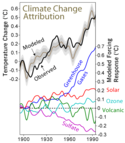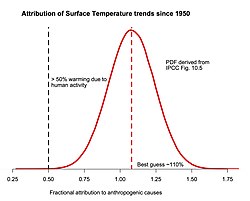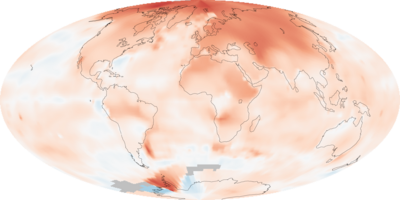3 examples of internal climate variability (1950-2012), the El Niño – Southern Oscillation, the Arctic Oscillation, and the North Atlantic Oscillation (NOAA)
In the top graph, the ENSO cycle is measured using the Oceanic Niño Index or ONI (for details, see NOAA Climate Program Office, 2009a). In the middle graph, the AO is measured using the Arctic Oscillation Index (for details, see NOAA Climate Program Office, 2009b). In the bottom graph, the NAO is measured using the North Atlantic Oscillation Index (for details, see NOAA Climate Program Office, 2009c).
References: IPCC, 2001: Appendix I - Glossary: Climate variability, in: Climate Change 2001: The Scientific Basis. Contribution of Working Group I to the IPCC Third Assessment Report (J.T. Houghton, et al., (eds)). Cambridge University Press; NOAA Climate Program Office, August 30, 2009a: ClimateWatch Magazine » Climate Variability: Oceanic Niño Index. NOAA; NOAA Climate Program Office, August 30, 2009b: ClimateWatch Magazine » Climate Variability: Arctic Oscillation. NOAA; NOAA Climate Program Office, August 30, 2009c: ClimateWatch Magazine » Climate Variability: North Atlantic Oscillation. NOAA.
Relevantní obrázky







Image source: Canty, T., Mascioli, N. R., Smarte, M. D., and Salawitch, R. J.: An empirical model of global climate – Part 1: A critical evaluation of volcanic cooling, Atmos. Chem. Phys., 13, 3997–4031, https://doi.org/10.5194/acp-13-3997-2013, 2013.
Original plot: US National Climate Assessment 4.
Merging of factors into composite lower panel and common °F scale: User:RCraig09.
Translation and °C scale: User:DeWikiMan, CC BY-SA 4.0








Relevantní články
Atribuce probíhající klimatické změnyAtribuce probíhající klimatické změny, nebo připisování probíhající klimatické změny jednotlivým příčinám je úsilí vědecky zjistit mechanismy odpovědné za probíhající globální oteplování a související změny klimatu na Zemi. Úsilí se zaměřilo na změny pozorované během období instrumentálních teplotních záznamů, zejména za posledních 50 let. To je období, kdy se lidská činnost nejvíce zintenzivněla a zároveň jsou k dispozici detailní pozorování troposféry. Podle Mezivládního panelu pro změnu klimatu (IPCC) je „extrémně pravděpodobné“, že lidský vliv byl v letech 1951 až 2010 dominantní příčinou globálního oteplování, podle některých zdrojů bylo pozorované oteplování od roku 1951 způsobeno výhradně lidmi. .. pokračovat ve čtení
